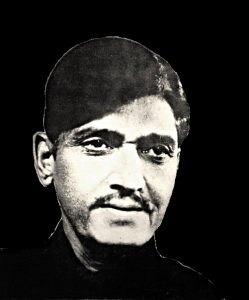| Told by | Sri Debabrata Mukhapadhyay |
| Obtained by | Sri Debabrata Mukhapadhyay, Rajeswary Ganguly Banerjee |
| Date | 28th September, 2016 |
| Place | Tarashankar Sarani,Tala,Kolkata |
| About the speaker | Associated to All India Radio, Kolkata. He presented several eye-opening discussions on Indian classical music. A poet, writer, and music connoisseur. |
| Tags | Akashvani, Radio, Taan, Raag, Jog, Bandish, Baroaa, 1968, 1967, Latafat Hussain Khan, Agra Gharana, Faiyaz Khan, Bialayat Hussain Khan, Sarafat Hussain Khan, 1960, 1962, Behug, Mulatani, Kheyal, Kirana Gharana, Roshanara Begum, Gwalior Gharana, Bade Ghulam Ali, Narendranath Mitha, Shovona Debi, Nitai Bose, Mustaque Ali khan, Nirmal Guha Thakurata, Ahmed Jan Thirakwa, Puriya, Tarapada Chakraborty, Halak Taan, Gamak, Meer, Meend, Boltaan, Dinkar Kaikini |
| Language | Bengali |
Sri Debabrata Mukhapadhyay Speaks :
Text Version:
I first started to listen to classical music from All India Radio from 7:40 to 7:50 p.m. One day suddenly an ethereal voice hit me and his tana was like a tidal wave. he was singing raga Jog “sajana mora ghar aye”.

He was the best yogi in that raga, he was none other than Latafat Hussain Khan. Another raga was his fort as far as I can remember, raga Baroya, “prem baje mori payeliya” was the lyrics of the kheyal. It was in the year 1968 or 69. He was in the peak of his career then. The records though were earlier ones. His voice taught me the strength in rendering a raga. Some people criticise him for his rough and husky voice, but I think beauty lies not only in softness and sweetness but also in strong masculinity. I think the beauty of Himalaya is not ultimate but the Grand Canyon is also beautiful in its own way. The voice of Latafat Hussain Khan reminds me of the tough granites of Grand Canyon. It was a very typical trait of Agra gharana, it was in the singing of Faiyaz khan too. I know the staunch fans of Faiaz Khan would beg to differ but I think the roughness and strength were the beauty of these singers. Bilayat Hussain Khan was another name in this line which I want to mention. Sharafat Hussain Khan changed himself a little from the common Agra gharana traits, still the beauty of the learning remained the same. Sharafat Hussain Khan had a record which I first heard in 1960 or 62. It had raga Behag in one side and raga Multani in the other. Behug had the lyrics “hajarat ali tum ho mahabali”, a typical kheyal of Agra gharana and Multani had the lyrics like “hari eri ariri, elo durjan me kaha Kasur”. These two songs, sung at the age of twelve, had a sweet young voice yet it had the fire and speed that was amazing. Then Kirana gharana recorded the same ragas by a twelve-year-old, she was none other than majestic Roshnara Begum. Those days are over now, the battle between ghranas and gurus are past. It is unfortunate that we lost the traits of different gharanas. The strength of Agra gharana, the beauty of Himalaya in Gwaliyar Gharana, the beauty of rose garden in the voice of Ghulam Ali Khan are all mixed up now. Even the time of the ragas are not considered now-a-days.
I was first introduced with Latafat Hussain khan in the house of famous writer Narendranath Mitra. His wife Shovana aunty was a very good singer. Nitai Basu was there, he was a disciple of Mustaque Hussain Khan and he liked me a lot. Nirmal Guhathakurta was also there. Latafat Hussain khan was chatting with them in a friendly manner. It was in Mohan Kanan, the year was 1967-68. I was introduced casually with him, I was awestruck. I first perceived him as a very big man wearing a white coat and white churidar, his dark face was reddened by betel leaf. He laughed and chatted merrily with a weird grin. His chat was mixed with Urdu Shayri which I couldn’t followed well but everyone was effusive. This went on for a while, I asked him some questions, the mood was set and then he took the stage. He started with raga Puriya. I remembered the small record of Ustad Tarapada Chakraborty with raga Puriya. But it had the very different flavour, it was full of sweet and mellow tragic note, we know this sadness which Puriya brings with it. But the rendering of Latafat Hussain was unique, we are in an unknown territory, the tragedy, the misfortune brought out by him was like a princess prisoned in a casement and her heart-wrenching catastrophe singing her heart out. But it was not a she and the singer was not a paragon of beauty. But he created his magic in such a way, we were all mesmerised. When he finished his performance, I suddenly discovered he was not at all a big man, he had quite a simple stature but the greatness of his genius made him a giant for me. He then sang some more songs including raga Jog. His introductory tana was so strong that it seemed to pull the very soul of ones existence. It was called Halak taan, it was a signature of Agra gharana, so also gamak. Gamak was originally a meer but they mixed boltaan with it to extend its merit. It was quite a lost heritage now. Sharafat Hussain Khan and Dinkar kaikini were the last of them.
TRANSLATION BY ARUNDHATI BANERJEE
Picture Courtesy:Google
https://www.google.co.in/search?q=ustad+latafat+hussain+khan&source=lnms&tbm=isch&sa=X&ved=0ahUKEwjn4NWi8fHbAhXMrI8KHaTzB74Q_AUIDCgD&biw=1366&bih=586#imgrc=AX4h1QgwpvKPaM:
Edited & Designed: Ms. Rajeswary Ganguly Banerjee
Data processed at SAP-DRS Lab, Department of Instrumental Music, Rabindra Bharati University.
